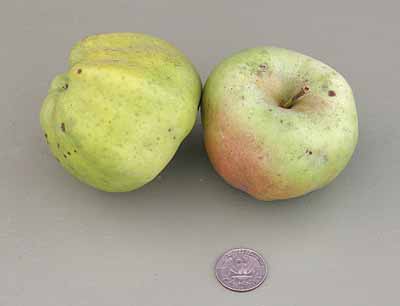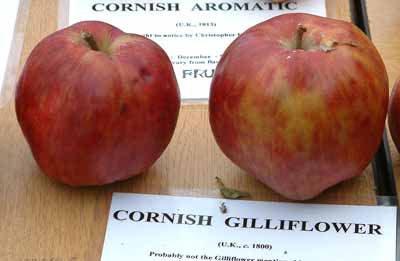Calvados is a department and region on the coast in Normandy, in Basse-Normandie, in northern France. Mainly low lying with the Normandy hills in the south west. A reef extending along the coast, between the Orne and Vire rivers, was named Les Calvados after a Spanish vessel was wrecked there in 1588. There is extensive stock rearing and dairy farming. Produces cider and Calvados apple brandy. Chief towns are Caen, Bayeux, Falaise and Lisieux.
Pestle puffball. A type of mushroom not generally considered to be edible but can be eaten when young.
A group of apples, all carrying the name Calville. The quality they have in common is that they have pronounced ribbed, crowned shape.

A variety of cooking and eating apple originally recorded in France by Le Lectier as Calville Blanc in 1628. It keeps its shape when it is cooked and is high in Vitamin C. This is a large, yellowish-green apple with very fine flesh which is tender, sweet, juicy and slightly acid. It has white speckles on the sunny side. It is now not very common. It is a late-season variety which is picked from mid- to late-October in South-East England, is stored and is at its best from November to December, mellowing on storage. In the United States it is a mid-season apple. It was first recorded as Blanche de Zurich in 1598.

This conical eating apple, better known as Cornish Gillyflower, was found in a garden in Truro in Cornwall in about 1800 and has a pentagonal base. It is dull green flushed blushed and striped with clear dark red and webbed with some russet. 'Gillyflower' comes from the old French word girofle, meaning clove-scented. By nature these are tip bearing trees, so you can't grow them as cordons or fans. This is a spicy, late-ripening apple which is picked from mid-October in South-East England and is at its best from November to January. They need to be kept in a cold store so they don't shrivel.
Streaked gurnard. Gurnards are strange-looking, bottom-feeding fish which use the three bottom rays of their pectoral fins to "feel" the sea bed. They have firm-textured white meat with not much flavour. They are rich in protein, iodine and phosphorus. The grey gurnard (Eutrigla gurnardus) has a brownish-grey back and silver belly. The red gurnard (Aspitrigla cuculus) is the most attractive member of the family with pinkish-red colour and the finest flavour of the gurnards. The tub gurnard (Trigla lucerna) is a large brownish-orange variety with bright orange pectoral fins and is the one most readily available in the United Kingdom. There is a variety known as flying gurnard as it is a fine swimmer which sometimes leaps out of the water. They are all very bony fish. Small ones are excellent in soup. Red or grey mullet (US: striped mullet) can generally be substituted for it, and are usually better!
A soft cheese made with sheep's milk flavoured with thyme and bay leaves. It has a creamy white paste and is made on farms in the Camargue.
Crowberry. A berry rather similar to cranberries but with a black skin, found growing on a shrub in the hills of northern Europe.